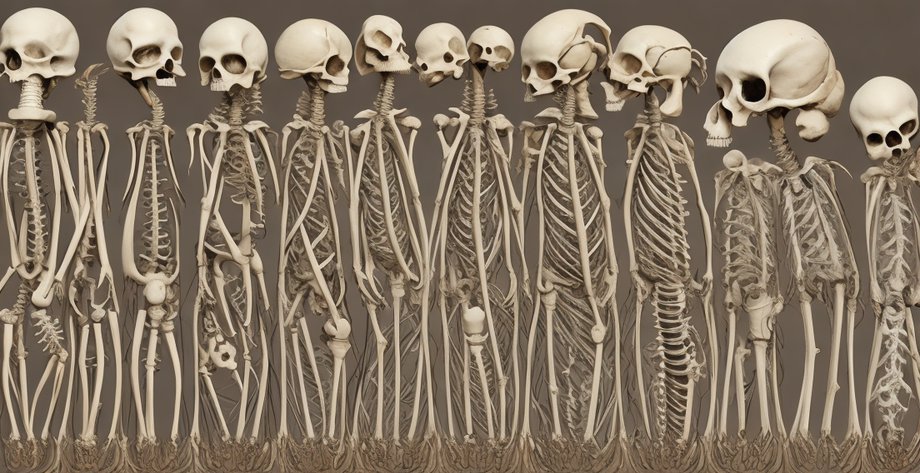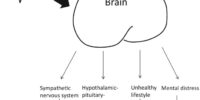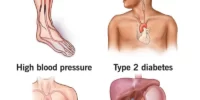Bone Development And Growth Explained

Bone development and growth is a complex process that involves various factors such as genetics, nutrition, hormones, and physical activity. Bones provide structural support to the body and protect vital organs, but they also play a crucial role in blood cell production, mineral storage, and calcium regulation. Understanding the basics of bone anatomy and structure, as well as the stages of bone development, can help us appreciate the importance of maintaining good bone health throughout our lives.
Different types of bones in the human body have distinct shapes and functions. While long bones such as the femur and humerus provide support and leverage for movement, flat bones such as the skull and sternum protect organs and provide attachment sites for muscles. Additionally, short bones such as those in the wrist and ankle are essential for stability and shock absorption.
The complex interplay between these bones, along with joints, ligaments, and tendons, enables us to perform a vast range of activities from walking to playing sports. In this article, we will explore the various factors that influence bone development and growth, and how we can take steps to promote optimal bone health.
Key Takeaways
- Bones provide structural support, protect organs, and play a role in blood cell production, mineral storage, and calcium regulation.
- Stages of bone development include osteogenesis, ossification, and remodeling.
- Factors affecting bone health include genetics, lifestyle choices, hormonal changes, medical conditions, and medications.
- Adequate nutrition, physical activity, and hormone replacement therapy can improve bone health.
The Basics of Bone Anatomy and Structure
The fundamental understanding of bone anatomy and structure is essential in comprehending the intricacies of bone development and growth.
Bones are living tissues that are made up of various types of cells, including osteoblasts, osteocytes, and osteoclasts.
Osteoblasts are responsible for producing the bone matrix, while osteocytes are mature bone cells that help maintain bone tissue. Osteoclasts, on the other hand, are responsible for breaking down and resorbing bone tissue.
Bones consist of two main types of bone tissue: compact bone and spongy bone.
Compact bone is dense and hard, making up the outer layer of most bones, while spongy bone is porous and less dense, found mostly in the inner layer of bones.
The bone matrix, which gives bone its strength and hardness, is made up of collagen fibers and calcium phosphate crystals.
The combination of collagen and calcium phosphate gives bone its unique properties, allowing it to withstand the forces of daily life.
Understanding the basic anatomy and structure of bone is crucial in comprehending bone development and growth.
Different Types of Bones in the Human Body
Various classifications exist for the different types of bones found in the human body. The two main classifications are based on shape and location. Based on shape, bones can be classified into long bones, short bones, flat bones, and irregular bones. Long bones are characterized by their elongated shape and are found in the arms, legs, fingers, and toes. Short bones are roughly cuboidal in shape and are found in the wrist and ankle. Flat bones are thin and flat and are found in the skull, scapulae, sternum, and ribs. Irregular bones have complex shapes and are found in the vertebrae, pelvis, and facial bones.
Based on location, bones can be classified into axial bones and appendicular bones. Axial bones are those that are located along the central axis of the body, including the skull, vertebral column, and ribcage. Appendicular bones are those that are located in the limbs and girdles, including the arms, legs, shoulder girdle, and pelvic girdle. Understanding the different types of bones in the human body is crucial for understanding bone development and growth.
| Bone Type | Description |
|---|---|
| Long Bones | Elongated shape found in the arms, legs, fingers, and toes. |
| Short Bones | Roughly cuboidal in shape found in the wrist and ankle. |
| Flat Bones | Thin and flat found in the skull, scapulae, sternum, and ribs. |
| Irregular Bones | Complex shapes found in the vertebrae, pelvis, and facial bones. |
| Axial Bones | Located along the central axis of the body, including the skull, vertebral column, and ribcage. |
| Appendicular Bones | Located in the limbs and girdles, including the arms, legs, shoulder girdle, and pelvic girdle. |
This table can help visualize the different types of bones found in the human body and their corresponding description. It can be useful for students and researchers who are studying bone development and growth. It also highlights the diversity of bone shapes and functions, which is an important aspect of the human body’s structural complexity.
Stages of Bone Development and Growth
Different stages in the process of bone formation can be identified through various markers and indicators, providing insight into the complex mechanisms underlying skeletal development.
The first stage of bone development is called osteogenesis, which involves the formation of bone tissue from mesenchymal stem cells. During this stage, the mesenchymal stem cells differentiate into osteoblasts, which are responsible for producing the extracellular matrix of bone tissue. As the extracellular matrix accumulates, it becomes mineralized, forming the rigid structure of bone.
The second stage of bone development is called ossification, which involves the conversion of cartilage tissue into bone tissue. During this stage, chondrocytes, which are cells responsible for producing cartilage tissue, undergo hypertrophy and apoptosis. This leads to the formation of a cartilage scaffold, which is then invaded by blood vessels and osteoblasts. The osteoblasts produce bone tissue on the surface of the cartilage scaffold, which gradually replaces the cartilage tissue.
As the bone tissue matures, it undergoes remodeling, which involves the removal and replacement of old bone tissue by new bone tissue. This process is mediated by osteoclasts, which are cells responsible for breaking down old bone tissue, and osteoblasts, which are responsible for producing new bone tissue.
Factors Affecting Bone Health
Factors affecting bone health are crucial to understand in order to prevent the development of bone-related diseases and conditions, which can have significant negative impacts on an individual’s quality of life. There are several factors that can affect bone health, including genetics, lifestyle choices, and hormonal changes. Genetics can play a role in determining bone density, and individuals with a family history of osteoporosis may be more at risk for developing the condition. Lifestyle choices such as diet, physical activity, and smoking can also impact bone health. A diet lacking in calcium and vitamin D can lead to weaker bones, while regular physical activity can help maintain bone mass. On the other hand, smoking has been linked to decreased bone density and an increased risk of fractures.
Hormonal changes, particularly in women, can also affect bone health. During menopause, the decrease in estrogen production can lead to a loss of bone mass. Additionally, certain medical conditions and medications can impact bone health. For example, individuals with rheumatoid arthritis may be at increased risk for osteoporosis, and long-term use of corticosteroids can lead to bone loss. By understanding these factors and taking steps to promote bone health, individuals can reduce their risk of developing bone-related diseases and conditions and maintain a higher quality of life.
| Factor | Impact on Bone Health | Ways to Improve Bone Health |
|---|---|---|
| Genetics | Can determine bone density | Regular exercise, calcium and vitamin D supplementation |
| Lifestyle choices | Diet, physical activity, and smoking habits can impact bone health | Balanced diet, regular physical activity, quitting smoking |
| Hormonal changes | Decreased estrogen production can lead to loss of bone mass | Hormone replacement therapy, regular exercise, calcium and vitamin D supplementation |
| Medical conditions and medications | Rheumatoid arthritis and long-term use of corticosteroids can lead to bone loss | Treatment of underlying medical condition, regular bone density tests |
The Role of Genetics in Bone Development
Genetic factors play a significant role in determining an individual’s bone density and susceptibility to bone-related diseases. Genetic variations can influence the formation and metabolism of bone tissue, ultimately affecting bone health.
For example, certain genetic mutations can lead to the development of osteogenesis imperfecta, a rare genetic disorder that causes brittle bones and increased risk of fractures. Similarly, genetic variations can also affect the absorption and utilization of calcium, a vital mineral for bone development and growth.
In addition to genetic mutations, variations in genes related to hormone regulation can also influence bone health. For instance, mutations in the vitamin D receptor gene can affect the absorption and utilization of vitamin D, a hormone critical for calcium absorption and bone health. Similarly, mutations in the parathyroid hormone gene can lead to overproduction or underproduction of the hormone, resulting in abnormal bone growth and increased risk of fractures.
Understanding the genetic factors that influence bone development and growth is crucial in identifying individuals at risk of developing bone-related diseases and in developing personalized treatment plans to improve bone health.
The Importance of Nutrition for Bone Health
Adequate nutrition is essential for maintaining optimal bone health and preventing the onset of bone-related diseases. The human body requires a variety of nutrients to support bone development and growth, including calcium, vitamin D, vitamin K, magnesium, and phosphorus. These nutrients work together to support bone mineralization, which is the process by which minerals such as calcium and phosphorus are deposited onto the bone matrix, giving bones their strength and rigidity.
The table below summarizes the key nutrients involved in bone health, their functions, and food sources. It is important to note that while calcium is often considered the most critical nutrient for bone health, it is just one piece of the puzzle. Adequate intake of all the nutrients listed below is necessary for optimal bone health. Additionally, a diet rich in fruits and vegetables, lean proteins, and whole grains can support bone health by providing a variety of micronutrients and antioxidants that support overall health and reduce inflammation.
| Nutrient | Function | Food Sources | ||||
|---|---|---|---|---|---|---|
| Calcium | Essential for bone mineralization and muscle contractions | Dairy products, leafy greens, fortified foods | ||||
| Vitamin D | Promotes calcium absorption and bone mineralization | Fatty fish, egg yolks, fortified foods | ||||
| Vitamin K | Necessary for bone mineralization and blood clotting | Leafy greens, cruciferous vegetables, vegetable oils | ||||
| Magnesium | Plays a role in bone mineralization and muscle function | Nuts, seeds, legumes, whole grains | ||||
| Phosphorus | Important for bone mineralization and energy production | Dairy products, meat, fish, poultry | Calcium | Essential for bone and teeth health, nerve function, and muscle contraction | Dairy products, leafy greens, fortified foods |
Hormones and Bone Growth
Nutrition plays a crucial role in bone health, and inadequate intake of key nutrients can lead to weak bones and increased risk of fractures. However, nutrition is not the only factor that affects bone growth and development. Hormones also play a significant role in bone health, particularly during growth and development.
During childhood and adolescence, hormones such as growth hormone, insulin-like growth factor 1 (IGF-1), and sex hormones (estrogen and testosterone) are essential for bone growth and development. These hormones stimulate the growth of bone cells and help regulate bone remodeling, which is the process of breaking down old bone tissue and replacing it with new bone tissue.
As a result, hormonal imbalances or deficiencies during these critical periods can significantly impact bone health and development.
To better understand the role of hormones in bone growth and development, it’s essential to consider the following three key points:
- Hormones such as growth hormone and IGF-1 are essential for bone growth, particularly during childhood and adolescence.
- Sex hormones such as estrogen and testosterone play a crucial role in maintaining bone health throughout adulthood.
- Hormonal imbalances or deficiencies can significantly impact bone health and development, leading to conditions such as osteoporosis.
Physical Activity and Bone Health
Physical activity has been shown to have a positive impact on bone health, particularly in terms of increasing bone density and reducing the risk of fractures. This is because when bones are subjected to mechanical stress from physical activity, they respond by increasing their mineral content and density. This process, known as bone remodeling, is an ongoing process throughout life that allows bones to adapt to changes in mechanical stress. Regular exercise that involves weight-bearing activities, such as walking, running, and weightlifting, can stimulate bone remodeling and lead to stronger bones.
The benefits of physical activity on bone health are well-documented, and it is recommended that individuals engage in regular exercise to maintain bone health. The table below summarizes the recommended types of physical activity for bone health, based on age and sex. It is important to note that these recommendations are just guidelines, and individuals should consult with their healthcare provider before starting any new exercise program. Additionally, it is important to engage in a variety of physical activities that incorporate weight-bearing and resistance exercises to maximize the benefits to bone health.
| Age | Recommended Physical Activity for Bone Health | |||
|---|---|---|---|---|
| Children and adolescents | At least 60 minutes of moderate-to-vigorous physical activity per day, including weight-bearing activities | |||
| Adults | At least 150 minutes of moderate-intensity aerobic activity or 75 minutes of vigorous-intensity aerobic activity per week, including weight-bearing and resistance exercises | |||
| Older adults | Same as adults, but with an emphasis on balance and coordination exercises to reduce the risk of falls | Pregnant women | Consult with a healthcare provider and aim for at least 150 minutes of moderate-intensity aerobic activity per week, with modifications as necessary |
Conclusion
In summary, bone development and growth are complex processes that are influenced by various factors such as genetics, nutrition, hormones, and physical activity.
Understanding the basics of bone anatomy and structure is crucial in comprehending the different types of bones in the human body and how they develop and grow throughout life.
Factors such as age, gender, and lifestyle choices can affect bone health, emphasizing the importance of adopting healthy habits such as a balanced diet, regular exercise, and avoiding smoking and excessive alcohol intake.
By taking care of our bones, we can prevent diseases such as osteoporosis and ensure a healthy and active life.
Therefore, it is essential to prioritize bone health from childhood to old age to maintain a strong and resilient skeletal system.








